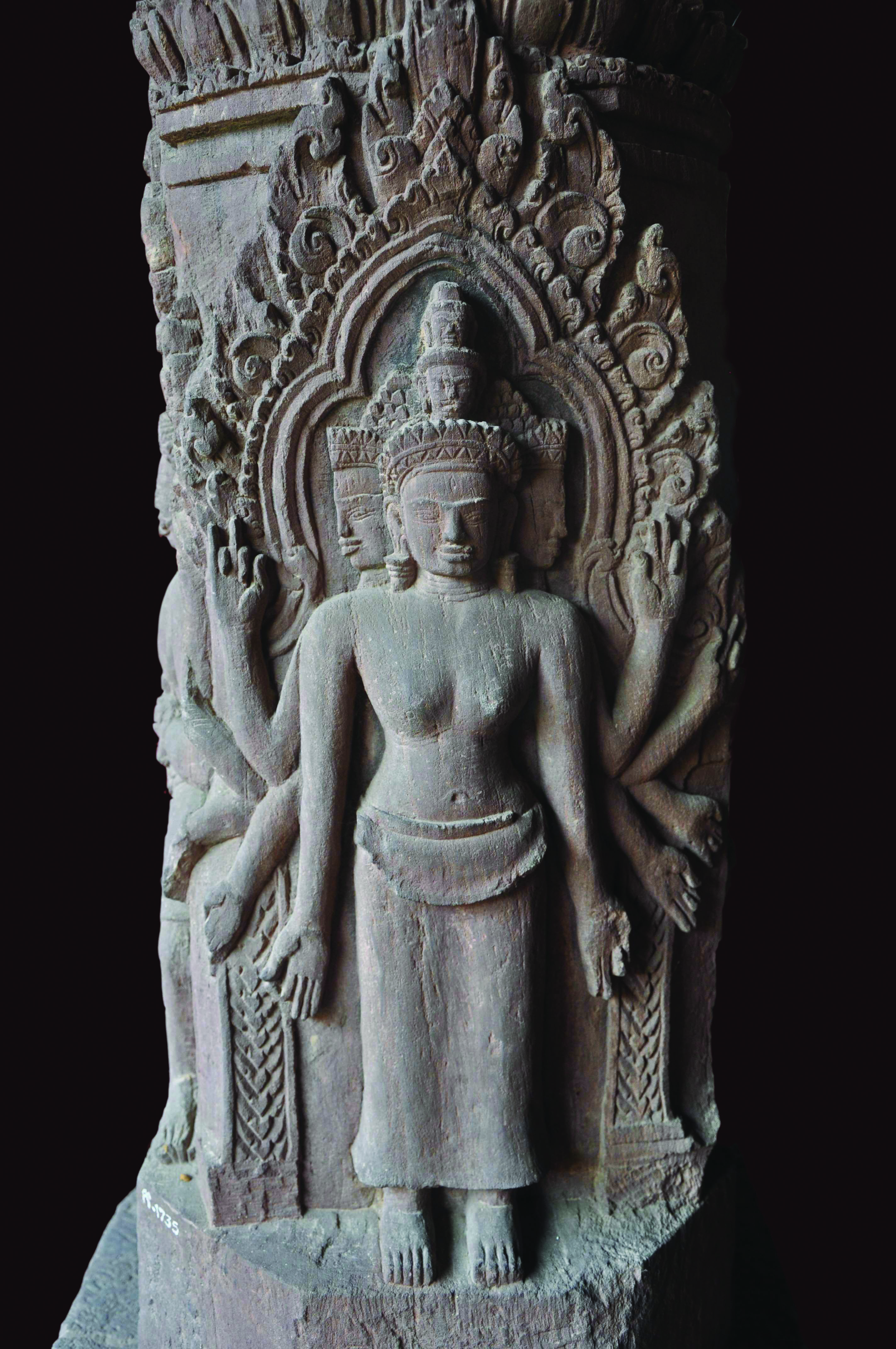Vajradhātvīśvarī and Vairocana Mirror Tantric Images in 10th-Century Cambodia
Main Article Content
Abstract
This article explores a collection of ten-armed, five-headedfigures featured in 10th-century Khmer Buddhist miniature shrines. While traditionally identified as representations of Prajñāpāramitā, the female deity embodying “the Perfection of Wisdom”, this article puts forth a new interpretation, suggesting these images depict the Khmer iteration of two dual tantric Buddhist deities, Vairocana and Vajradhātvīśvarī, linked to the Sarvatathāgatatattvasaṁgrahanāmamahāyānasūtra (STTS). The key insight for this hypothesis stems from an examination of a newly identified shrine located in the Battambang National Museum featuring mirrored male and female figures, prompting a reconsideration of their traditional identification. The link to the mentioned STTS text provides an explanatory framework for the unique iconographic features of these images.
Article Details
References
Primary Sources
Lokesh Chandra. 1995. Saṅ Hyaṅ Kamahāyānikan: Advaya Sādhana. In Cultural Horizons of India, by Lokesh Chandra, Vol. 4: 328-434. Delhi: Aditya Prakashan.
Lokesh Chandra & Snellgrove, David. 1981. Sarva Tathāgata Tattva Saṁgraha. Facsimile Reproduction of a Tenth Century Sanskrit Manuscript from Nepal. Delhi: Jayyed Press.
Secondary Sources
Baptiste, Pierre & Zéphir, Thierry. 2008. L’Art khmer dans les collections du musée Guimet. Paris: Réunion des musées nationaux.
Bhattacharyya, Benoytosh. 1968. Indian Buddhist Iconography. Mainly Based on the Sādhanamālā and Cognate Tantric Texts of Rituals. Calcutta: Mukhopadhyay.
Bunce, Frederick W. 2001. Mudras in Buddhist and Hindu Practices. New Delhi: D.K. Print World.
Chemburkar, Swati. 2022. Prajñāpāramitā and Khmer Esoteric Buddhism in the 10th to 13th Centuries. Oxford Research Encyclopedia of Religion. Published online: https://doi.org/10.1093/acrefore/9780199340378.013.760.
Cœdès, Georges. 1908. La stèle de Tép Pranam (Cambodge). Journal Asiatique 11: 203‒228.
———. 1951. Inscriptions du Cambodge, Tome III. Paris: EFEO.
———. 1954. Inscriptions du Cambodge, Tome VI. Paris: EFEO.
Dayal, Har. 1932. The Bodhisattva Doctrine in Buddhist Sanskrit Literature. London: Routledge.
Finot, Louis. 1925. Lokeçvara en Indochine. In Études asiatiques, Tome 1, 227–256. Paris: EFEO.
Ghosh, Manomohan. 1957. Nandikeśvara’s Abhinayadarpanam. Calcutta: Mukhopadhyay.
Green, Phillip. 2014. The Many Faces of Lokeśvara: Tantric Connections in Cambodia and Campā between the Tenth and Thirteenth. History of Religions 54(1): 69–93.
Gutschow, Niels & Gellner, David N. 1997. The Nepalese Caitya: 1,500 years of Buddhist Votive Architecture in the Kathmandu Valley. Stuttgart: Menges.
Huntington, John & Dina Bangdel. 2003. The Circle of Bliss. Chicago: Serindia.
Kim, Jinah. 2022. Goddess Prajñāpāramitā and Esoteric Buddhism in Jayavarman VII’s Angkor. In The Creative South. Buddhist and Hindu Art in Mediaeval Maritime Asia, ed. by Andrea Acri & Peter Sharrock, Vol. 1, 167‒191. Singapore: ISEAS.
Kwon, Do-Kyun. 2002. Sarva Tathāgata Tattva Saṁgraha, Compendium of All the Tathāgatas: A Study of Its Origin, Structure, and Teachings. Doctoral Dissertation, SOAS: University of London.
Lobo, Wibke. 1997. Caitya—Buddhistic Monument. In The Sculpture of Angkor and Ancient Cambodia: Millennium of Glory, ed. by Helen Jessup & Thierry Zéphir, 242–243. Washington: National Gallery of Arts.
Multzer O’Naughten, Hedwige. 2016. Prajñāpāramitā dans le bouddhisme du Cambodge ancien. Arts Asiatiques 71: 31–54.
Nair, Janaki. 2020. Performativity of Mudras: A Study on the Psychophysical Implications of Hand Gestural Practice in Kathakali and Tantra. Doctoral Dissertation, Newcastle: Northumbria University.
Piriya Krairiksh. 2012. The Roots of Thai Art. Bangkok: River Books.
Saunders, Dale E. 1960. Mudrā: A Study of Symbolic Gestures in Japanese Buddhist Sculpture. Princeton: Princeton University Press.
Sharrock, Peter. 2011. The Nāga-enthroned Buddha. In Khmer Bronzes: New Interpretations of the Past, ed. by Emma Bunker & Douglas Latchford, 481‒502. Chicago: Media Art Resources.
———. 2013. Kīrtipaṇḍita and the Tantras. Udaya 10: 203–237.
Skorupski, Tadeus. 1983. The Sarvadugatipariśodhana Tantra. Delhi: Motilal Banarsidass.
———. 1998. An Analysis of the Kriyāsaṁgraha. In Sūracandaya: Essays in Honour of Akira Yuyama on the Occasion of His 65th Birthday, ed. by Paul Harrison & Gregory Schopen, 181‒196. Swisttal-Oldendorf: Indica et Tibetica Verlag.
———. 2002. The Kriyāsaṁgraha. Tring: Institute of Buddhist Studies.
Smith, Richard. 2015. Questions Regarding the Word Mudra. Published online: http://asianart.com/articles/mudra.
Snellgrove, David. 1987. Indo-Tibetan Buddhism: Indian Buddhists and their Tibetan Sources. Boston: Shambala.
Woodward, Hiram. 2007. The Kāraṇḍavyūha Sutra and Buddhist Art in 10th-Century Cambodia. In Buddhist Art: Form and Meaning, ed. by Pratapaditya Pal, 70‒83 Mumbai: Marg Publications.
———. 2015. Aspects of Buddhism in Tenth-Century Cambodia. In Buddhist Dynamics in Pre-modern and Early Southeast Asia, ed. by Christian Lammerts, 228‒260. Singapore: ISEAS.


